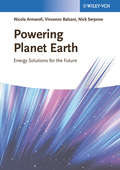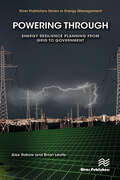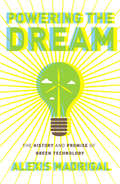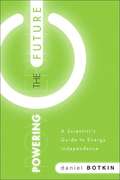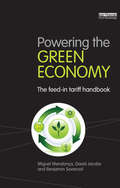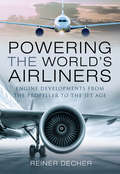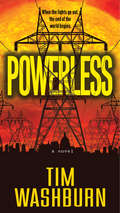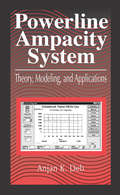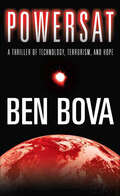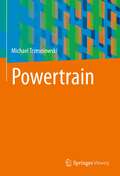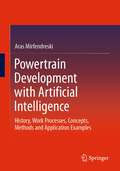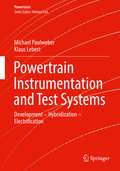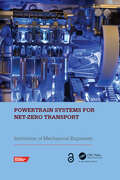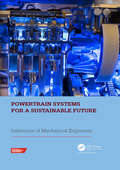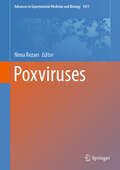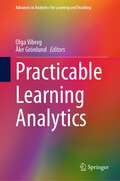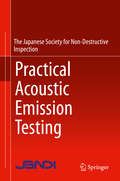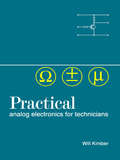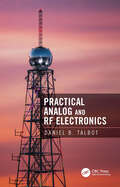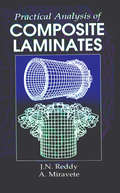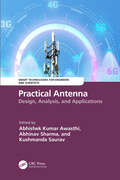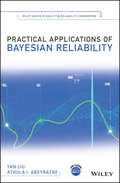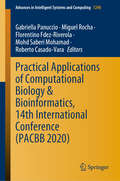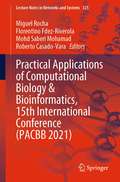- Table View
- List View
Powering Planet Earth: Energy Solutions for the Future
by Vincenzo Balzani Nicola ArmaroliIn their book Nicola Armaroli, Vincenzo Balzani and Nick Serpone uncover the background details associated with a transition to sustainable energy production that are routinely swept under the table in public discussions. They are not only concerned with the (alleged) advantages and disadvantages of any one energy generation technology from a technical viewpoint, but also with the ecological, economic, political and social consequences of an inevitable transition. In a highly readable manner aimed at an international audience, the authors introduce the often misused and sometimes abused term 'energy' and give a lucid account of the development of energy production from timber to nuclear energy and renewable energies. They compare various energy generation methods with respect to their efficiency and practicability for large-scale implementation and examine if, and how, these methods live up to the expectations and promises their proponents make. In addition, the authors juxtapose the political and economic prerequisites in different regions of the world that advance, or hinder, an energy turnaround. They round off their book by debunking the seventeen most popular myths often cited in discussions on energy issues. As a result, the authors provide ammunition for debate, underpin (and unsettle) opinions using facts, and challenge comfortable and popular chains of reasoning.
Powering Through: Energy Resilience Planning from Grid to Government
by Brian Levite Alex RakowThe threats to the electricity grid are on the rise at the same time as society is increasing its dependence on electricity for every aspect of our personal, social, and economic lives. We are accelerating that dependence – looking to the electrification of transportation and buildings as a way to stem the threats of climate change. Those threats have now arrived (in the form of more extreme weather, droughts, and wildfire) and they are joined by increasing threats from an aging grid and cyberattacks. The grid we rely on is experiencing increasingly vulnerable external forces. We aren’t helpless. Effective planning around these threats can dramatically reduce the havoc they engender on the electric grid. At every level, from a single building, to a city, to the electric grid and the federal government, steps can be taken to improve our resilience to threats to the electricity system. When those efforts are coordinated, their benefits multiply. This book aims to provide every level of decision-maker with tools and best practices for reducing the risk of and from electricity loss. It is written in non-technical language, with a focus on actionable, easily implemented steps.
Powering the Dream: The History and Promise of Green Technology
by Alexis MadrigalFew today realize that electric cabs dominated Manhattan's streets in the 1890s; that Boise, Idaho, had a geothermal heating system in 1910; or that the first megawatt turbine in the world was built in 1941 by the son of publishing magnate G. P. Putnam--a feat that would not be duplicated for another forty years. Likewise, while many remember the oil embargo of the 1970s, few are aware that it led to a corresponding explosion in green-technology research that was only derailed when energy prices later dropped.In other words: We've been here before. Although we may have failed, America has had the chance to put our world on a more sustainable path. Americans have, in fact, been inventing green for more than a century.Half compendium of lost opportunities, half hopeful look toward the future, Powering the Dream tells the stories of the brilliant, often irascible inventors who foresaw our current problems, tried to invent cheap and energy renewable solutions, and drew the blueprint for a green future.
Powering the Future: A Scientist's Guide to Energy Independence
by Daniel B. BotkinThe future of civilization depends upon the continuous availability of sufficient energy. But we're approaching the practical limits of some of the energy sources we depend upon most. What should be done? Few issues are as controversial. In Powering the Future, a leading scientist cuts through the controversy, presenting the facts about our energy needs, desires, and supplies and the environmental and human effects of obtaining and using energy. Dr. Daniel B. Botkin objectively assesses the true prospects, limitations, costs, risks, dangers, and tradeoffs associated with every leading and emerging source of energy, including oil, natural gas, coal, hydroelectric, nuclear, wind, solar, ocean power, and biofuels. Next, Botkin addresses the energy distribution system, outlining how it currently works, identifying its inefficiencies, and reviewing options for improving it. Finally, Botkin turns to solutions, offering a realistic, scientifically and economically viable path to a sustainable, energy-independent future: one that can improve the quality of life for Americans and for people around the world. THE FUTURE OF FOSSIL FUELS-- What can we realistically expect from oil, gas, and coal? WILL ALTERNATIVE ENERGY SOURCES REALLY MATTER? Running the numbers on solar, wind, biofuels and other renewables. MUST WE ALL WEAR SWEATERS AND LIVE IN CAVES? The right role for efficiency--and why energy minimalism isn't the solution. WHERE WE CAN START--AND WHAT WILL HAPPEN IF WE DON'T? No magic bullet, but there are sensible, realistic solutions.
Powering the Green Economy: The Feed-in Tariff Handbook
by Miguel MendoncaEffective policy is vital for creating greener economies, new jobs and industries, for securing energy supplies and for protecting the climate and environment. As renewable energy is fundamental to achieving all of these objectives, it too needs the best possible policy to drive it. Feed-in tariffs have proven to deliver the fastest, most cost-effective and inclusive deployment, by allowing anyone to sell renewable energy into the grid and get a long term, guaranteed return for it. This book, from authors who have spent years working on feed-in tariff design and advocacy, provides a broad and detailed resource on feed-in tariffs and other renewable energy support schemes. It shares many lessons on good and bad design and implementation, as well as discussing the challenges faced by policy, and renewable energy in general. Powering the Green Economy: - Situates renewable energy and feed-in tariffs within the context of the global moves towards a green economy - Provides an introduction to feed-in tariffs and brings developments in key countries around the world up to date - Investigates effective design for developed and emerging economies - Explores technical, social and political issues - Analyses other support schemes - Describes the barriers to renewable energy - Presents a blueprint for campaigning successfully for feed-in tariffs Written in a clear, practical style, this is a must-read for policymakers, businesses, investors, campaigners, academics, community groups and anyone concerned with creating successful and sustainable energy policy.
Powering the World's Airliners: Engine Developments from the Propeller to the Jet Age
by Reiner DecherFrom propellers to turbofans, this illustrated history of engines will be “of interest to modelers and aviation historians alike” (AMPS Indianapolis).The first efforts of man to fly were limited by his ability to generate sufficient power to lift a heavier-than-air machine off the ground. Propulsion and thrust have therefore been the most fundamental elements in the development of aircraft engines.From the simple propellers of the first airliners of the 1920s and 1930s, to the turboprops and turbojets of the modern era, the engines used in airliners have undergone dramatic development over a century of remarkable change. These advances are examined in detail by aeronautical engineer Reiner Decher, who provides a layman’s guide to the engines that have, and continue to, power the aircraft that carry millions of travelers across millions of miles each year. Decher also looks at the development of aero engines during the Second World War and how that conflict drove innovation and explains the nature of wing design, from the early twentieth century to the present.To enable an easy understanding of this intriguing subject, Powering the World’s Airliners is profusely illustrated, transporting readers back to the time of each major development and introducing them to the key individuals of the aero industry in each era. After reading this comprehensive yet engaging story of the machines that power the aircraft in which we fly, no journey will ever seem quite the same again.
Powerless
by Sam TranumThis is a book about India's energy shortage, its causes, and consequences. Powerless details how much coal, oil, gas, uranium, and power the country uses, and for what purposes. It examines the quantity of these things the country produces and where. The book looks at the sizes of the gaps between supply and demand, and how the country fills them with imports. It then discusses how the shortages and resulting imports affect the country's economy, businesses, and residents. After examining the current scenario, the author moves on to look at predictions for how fast demand and supply will grow, how big the shortages of natural resources might become in the next few years, and whether India is likely to be able--politically, logistically, and financially--to fill these gaps with imports. The book also looks at the environmental and health effects of India's growing energy use, and how efforts to mitigate these are likely to affect demand for coal, oil, gas, and uranium.
Powerless
by Tim WashburnNothing Can Prepare You. . .It strikes without warning. A massive geomagnetic solar storm that destroys every power grid in the northern hemisphere. North America is without lights, electricity, phones, and navigation systems. In one week, the human race is flung back to the Dark Ages. Nothing Can Save You. . .In Boulder, Colorado, weather technicians watch in horror as civilization collapses around them. Planes are falling out of the skies. Cars are dead. Pandemonium and terror grip the Northern Hemisphere. As nuclear reactors across North America face inevitable meltdowns, the U.S. President remains powerless in a heavily guarded White House. From London to Boston to Anchorage, there is no food, no water, no hope. It's every man for himself. . .and it will only get worse. Survival Is Everything. Only one man--army veteran Zeke Marshall--is prepared to handle a nightmare like this. But when he tries to reunite with his family in Dallas--across a lawless terrain as deadly as any battlefield--he discovers there are worse things in life than war. And there are terrible and unthinkable things he'll have to do to survive. . .
Powerline Ampacity System: Theory, Modeling and Applications
by Anjan K. DebCivilization's demands for electricity continue to grow, yet environmental, regulatory, and economic constraints often preclude the construction of new power plants and transmission lines. The challenge now faced by engineers, equipment manufacturers, and regulatory agencies is to find ways to maximize the capacity of existing power lines.Powerline Ampacity System is the first step in meeting that challenge. Along with developing a complete theory of transmission line ampacity, the author uses object-oriented modeling and expert rules to build a power line ampacity system. He describes new transmission line conductor technologies and power electronics FACTS devices that can take full advantage of a dynamic line rating system. He offers examples that clearly show the economic benefit of operating an interconnected transmission network that has a diverse mix of electricity generation sources. He also discusses - with examples - generator stability enhancement by dynamic line rating.
Powersat: A Thriller of Technology, Terrorism, and Hope (The Grand Tour)
by Ben BovaOil cartels and deadly terrorists threaten one man’s work to generate clean energy in this science fiction thriller by the six-time Hugo Award–winning author.Two hundred thousand feet up, things go horribly wrong. The experimental low-orbit spaceplane Astro falls to earth over a trail hundreds of miles long. In the wake of this disaster is the beginning of the most important mission in the history of space.Entrepreneur Dan Randolph is determined to provide energy to a desperate world. He dreams of an array of geosynchronous powersats, satellites which gather solar energy and beam it to generators on Earth, breaking the power of the oil cartels forever. But the wreck of the experimental spaceplane has left his company on the edge of bankruptcy.Worse, Dan discovers the plane worked perfectly right up until the moment that saboteurs knocked it out of the sky. And whoever brought it down is willing and able to kill again to keep Astro grounded. . . .Praise for Powersat“[Bova] supplies a suspenseful ride and plenty of high-tech hardware.” —Publishers Weekly“Tom Clancy-like danger and intrigue!” —Amazing“A classic guy’s tale. . . . Bova is a spare writer who nevertheless crafts the perfect voice for each of his characters.” —San Antonio Express-News
Powertrain
by Michael TrzesniowskiIn this book, the reader learns the essential differences to the passenger car through the analysis divided according to assemblies. This gives him the tools to apply the detailed knowledge acquired to the design and development of competition vehicles. In the case of internal combustion engines, the focus is on performance-enhancing measures for racing vehicles. From the choice of the number of cylinders to the intake system to the exhaust system, the lever can be applied to every assembly. For electric drives, the traction battery, cell selection, cooling and operating strategy are considered in more detail. Energy recovery systems are an interesting enhancement for hybrid vehicles and all-electric powertrains, especially in strategic considerations for racing. Finally, gearboxes are needed independently of the drive source, albeit matched to it, so that the full potential can be exploited. The detailed, in-depth presentation makes this work just as suitable for the interested motorsport enthusiast as it is for the engineer in the field who is addressing the issues surrounding race car powertrains. The formula material is prepared in such a way that the book can also be used as a reference work.
Powertrain Development with Artificial Intelligence: History, Work Processes, Concepts, Methods and Application Examples
by Aras MirfendreskiThe variety of future powertrain concepts has drastically increased the development cost for automotive manufactures. Profitable investment requires a significantly leaner and efficient powertrain development process. Traditional methods of test and model based development need to be assisted by big data and data analytics. For this purpose, a valuable tool is available at the right time - artificial intelligence (AI). But what does AI really mean in a narrower sense? What concepts lie behind it? And how are the methods and algorithms transferable to powertrain applications? For the first time, this book aims to bridge the gap between automotive engineering and computer science, by illuminating the complexity of current AI concepts and demystifying it for powertrain applications. By elaborating on work processes, it shows how AI could be implemented and how completely novel methods can help us reshape the future of mobility.
Powertrain Instrumentation and Test Systems
by Michael Paulweber Klaus LebertThe bookdeals with the increasingly complex test systems for powertrain components andsystems giving an overview of the diverse types of test beds for allcomponents of an advanced powertrain focusing on specific topics such asinstrumentation, control, simulation, hardware-in-the-loop, automation or testfacility management. This book is intended for powertrain (component)development engineers, test bed planners, test bed operators and beginners.
Powertrain Systems for Net-Zero Transport
by Institution of Mechanical EngineersThe transport sector continues to shift towards alternative powertrains, particularly with the UK Government’s announcement to end the sale of petrol and diesel passenger cars by 2030 and increasing support for alternatives. Despite this announcement, the internal combustion continues to play a significant role both in the passenger car market through the use of hybrids and sustainable low carbon fuels, as well as a key role in other sectors such as heavy-duty vehicles and off-highway applications across the globe. Building on the industry-leading IC Engines conference, the 2021 Powertrain Systems for Net-Zero Transport conference (7-8 December 2021, London, UK) focussed on the internal combustion engine’s role in Net-Zero transport as well as covered developments in the wide range of propulsion systems available (electric, fuel cell, sustainable fuels etc) and their associated powertrains. To achieve the net-zero transport across the globe, the life-cycle analysis of future powertrain and energy was also discussed. Powertrain Systems for Net-Zero Transport provided a forum for engine, fuels, e-machine, fuel cell and powertrain experts to look closely at developments in powertrain technology required, to meet the demands of the net-zero future and global competition in all sectors of the road transportation, off-highway and stationary power industries.
Powertrain Systems for a Sustainable Future: Proceedings of the International Conference on Powertrain Systems for a Sustainable Future 2023, London, UK, 29- 30 November 2023
by Institution of Mechanical EngineersThe transport sector continues to shift towards alternative powertrains, particularly with the UK Government’s focus on ending the sale of petrol and diesel passenger cars by 2030 and increasing support for alternatives. Despite this announcement, the internal combustion could continue to play a significant role both in the passenger car market through the use of hybrids and sustainable low carbon fuels including hydrogen, as well as a key role in other sectors such as heavy-duty vehicles and off-highway applications across the globe. The contributions presented at the International Conference on Powertrain Systems for a Sustainable Future 2023 (London, UK, 29- 30 November 2023) focus on the internal combustion engine’s role in net-zero transport as well as covering developments in the wide range of propulsion systems available (electric, hydrogen internal combustion engines and fuel cells, sustainable fuels etc) and their associated powertrains. To achieve a sustainable future for transport across the globe we will need to deploy all technologies and so, to help understand how these might fit together, life-cycle analysis of future powertrain systems and energy will also be included. Powertrain Systems for a Sustainable Future provides a forum for engine, fuels, e-machine, fuel cell and powertrain experts to look closely at developments in powertrain technology required to meet the demands of the net-zero future and global competition in all sectors of the road transportation, off-highway, marine and stationary power industries.
Poxviruses (Advances in Experimental Medicine and Biology #1451)
by Nima RezaeiSince the emergence of 2022’s monkeypox virus (MPXV) outbreak, it has been the heading of news and research articles that MPXV is being involving non-endemic areas after about its 80-year presence in endemic areas. Efforts are concentrated on understanding how MPXV has evolved to cause an epidemic. The book provides a comprehensive compendium of chapters on poxviruses in different domains. It concludes that the main problem we should deal with is not to address how MPXV has overcome the distance between non-endemic and endemic areas, but it is the non-cooperativity of logistics, research, and science in managing poxviruses’ outbreaks.
Practicable Learning Analytics (Advances in Analytics for Learning and Teaching)
by Olga Viberg Åke GrönlundThis book is about practicable learning analytics, that is able to become a successful part of practice, ultimately leading to improved learning and teaching. The aim of the book is to shift our perspective on learning analytics creation and implementation from that of “designing of” technology to that of “designing for” a system of practice. That is, any successful implementation of learning analytics requires a systematic approach, which the book explains through the lens of the Information Systems Artefact, constituting of the three interdependent artefacts: “technical”, “information” and “social”.The contributions of this book go beyond a consideration of particular humans such as teachers and students, and their individual activities to consider the larger systems of activity of which analytics become part of. The chapters included in this book present different cases of learning analytics implementation across countries, and the related opportunities and challenges related to generalizability of the results.The book is written for designers, students and educators of learning analytics who aim to improve learning and teaching through learning analytics.
Practical Acoustic Emission Testing
by The Japanese Society for Non-Destructive InspectionThis book is intended fornon-destructive testing (NDT) technicians who want to learn practical acousticemission testing based on level 1 of ISO 9712 (Non-destructive testing -Qualification and certification of personnel) criteria. The essential aspectsof ISO/DIS 18436-6 (Condition monitoring and diagnostics of machines -Requirements for training and certification of personnel, Part 6: AcousticEmission) are explained, and readers can deepen their understanding with thehelp of practice exercises. This work presents the guiding principles ofacoustic emission measurement, signal processing, algorithms for sourcelocation, measurement devices, applicability of testing methods, andmeasurement cases to support not only researchers in this field but also and especiallyNDT technicians.
Practical Analog Electronics for Technicians
by W A Kimber'Practical Analog Electronics for Technicians' not only provides an accessible introduction to electronics, but also supplies all the problems and practical activities needed to gain hands-on knowledge and experience. This emphasis on practice is surprisingly unusual in electronics texts, and has already gained Will Kimber popularity through the companion volume, 'Practical Digital Electronics for Technicians'. Written to cover the Advanced GNVQ optional unit in electronics, this book is also ideal for BTEC National, A-level electronics and City & Guilds courses. Together with 'Practical Digital Electronics for Technicians', this text comprises a complete practical electronics course designed for students with little prior knowledge of the subject.
Practical Analog and RF Electronics
by Daniel B. TalbotThis is a book about real-world design techniques for analog circuits: amplifiers, filters, injection-locked oscillators, phase-locked loops, transimpedance amplifiers, group delay correction circuits, notch filters, and spectrum regrowth in digital radio frequency (RF) transmitters, etc. The book offers practical solutions to analog and RF problems, helping the reader to achieve high-performance circuit and system design. A variety of issues are covered, such as: How to flatten group delay of filters How to use reciprocity to advantage How to neutralize a parasitic capacitance How to deepen a notch by adding only two components to the network How to demodulate a signal using the secant waveform and its benefit How to flatten the frequency response of a diode detector When to use a transimpedance amplifier and how to maximize its performance How to recover non-return-to-zero (NRZ) data when alternating current (AC) coupling is required Why phase noise corrupts adjacent communication channels Simple method to prevent false locking in phase-locked loops How to improve the bandwidth of amplification by using current conveyors A very simple impedance matching technique requiring only one reactive component How to use optimization Quadrature distortion and cross-rail interference This book is meant to be a handbook (or a supplemental textbook) for students and practitioners in the design of analog and RF circuitry with primary emphasis on practical albeit sometimes unorthodox circuit realizations. Equations and behavioral simulations result in an abundance of illustrations, following a "words and pictures" easy-to-understand approach. Teachers will find the book an important supplement to a standard analog and RF course, or it may stand alone as a textbook. Working engineers may find it useful as a handbook by bookmarking some of the step-by-step procedures, e.g., the section on simplified impedance matching or group delay flattening.
Practical Analysis of Composite Laminates (Applied and Computational Mechanics #1)
by Antonio Miravete J. N. ReddyComposite materials are increasingly used in aerospace, underwater, and automotive structures. They provide unique advantages over their metallic counterparts, but also create complex challenges to analysts and designers. Practical Analysis of Composite Laminates presents a summary of the equations governing composite laminates and provides practical methods for analyzing most common types of composite structural elements. Experimental results for several types of structures are included, and theoretical and experimental correlations are discussed. The last chapter is devoted to practical analysis using Designing Advanced Composites (DAC), a PC-based software on the subject. This comprehensive text can be used for a graduate course in mechanical engineering, and as a valuable reference for professionals in the field.
Practical Antenna: Design, Analysis, and Applications (Smart Technologies for Engineers and Scientists)
by Abhinav Sharma Abhishek Kumar Awasthi Kushmanda SauravAntennas are an important component of every communication systems, including radio, television, satellite, radar, and cellular networks which transmits and receive radio waves over the wireless channel. The field of antenna is quite vast, and with the current development in the wireless technologies enormous amount of work and effort has been put in the design, analysis, and applications of antennas. As an individual, a reader has to put a lot of effort to understand the modern antenna analysis and design for various applications. Therefore, the editors and authors of this book have come-up with an idea of putting all the necessary information required at one centralized place in the form of a book. The readers of this book will be able to access all the necessary information of antennas, from basic to advanced, theory to practical and its modern applications. The text provides information on antenna design for next generation communication systems and IoT applications, followed by the integration of the antennas in the wireless system, and also covers multi-input and multi-output (MIMO) antennas, metasurface antennas, reconfigurable antennas, fractal antennas and design of beamforming networks.This book: Focuses on modern antennas for 5G communication systems and next-generation Internet of Things (IoT) networks Highlights fractal radiator-based printed linear antenna arrays designed for direct broadcast satellite applications with a particular focus on direct-to home (DTH) services Covers the implementation of modern swarm intelligence optimization techniques for antenna array pattern synthesis Includes general framework for the design and optimization of metasurface antennas Presents design and development of high-gain millimeter-wave beam switching antennas using passive frequency selective surfaces (FSS) This book can also serve as a valuable reference for undergraduate, post-graduate students, as well as researchers working in radio frequency (RF) and microwave.
Practical Applications of Bayesian Reliability (Quality and Reliability Engineering Series)
by Yan Liu Athula I. AbeyratneDemonstrates how to solve reliability problems using practical applications of Bayesian models This self-contained reference provides fundamental knowledge of Bayesian reliability and utilizes numerous examples to show how Bayesian models can solve real life reliability problems. It teaches engineers and scientists exactly what Bayesian analysis is, what its benefits are, and how they can apply the methods to solve their own problems. To help readers get started quickly, the book presents many Bayesian models that use JAGS and which require fewer than 10 lines of command. It also offers a number of short R scripts consisting of simple functions to help them become familiar with R coding. Practical Applications of Bayesian Reliability starts by introducing basic concepts of reliability engineering, including random variables, discrete and continuous probability distributions, hazard function, and censored data. Basic concepts of Bayesian statistics, models, reasons, and theory are presented in the following chapter. Coverage of Bayesian computation, Metropolis-Hastings algorithm, and Gibbs Sampling comes next. The book then goes on to teach the concepts of design capability and design for reliability; introduce Bayesian models for estimating system reliability; discuss Bayesian Hierarchical Models and their applications; present linear and logistic regression models in Bayesian Perspective; and more. Provides a step-by-step approach for developing advanced reliability models to solve complex problems, and does not require in-depth understanding of statistical methodology Educates managers on the potential of Bayesian reliability models and associated impact Introduces commonly used predictive reliability models and advanced Bayesian models based on real life applications Includes practical guidelines to construct Bayesian reliability models along with computer codes for all of the case studies JAGS and R codes are provided on an accompanying website to enable practitioners to easily copy them and tailor them to their own applications Practical Applications of Bayesian Reliability is a helpful book for industry practitioners such as reliability engineers, mechanical engineers, electrical engineers, product engineers, system engineers, and materials scientists whose work includes predicting design or product performance.
Practical Applications of Computational Biology & Bioinformatics, 14th International Conference (Advances in Intelligent Systems and Computing #1240)
by Florentino Fdez-Riverola Mohd Saberi Mohamad Miguel Rocha Gabriella Panuccio Roberto Casado-VaraThis book highlights the latest research on practical applications of computational biology and bioinformatics, and addresses emerging experimental and sequencing techniques that are posing new challenges for bioinformatics and computational biology. Successfully applying these techniques calls for new algorithms and approaches from fields such as statistics, data mining, machine learning, optimization, computer science, and artificial intelligence. In response to these challenges, we have seen the rise of a new generation of interdisciplinary scientists with a strong background in the biological and computational sciences.These proceedings include 21 papers covering many different subfields of bioinformatics and computational biology. Focusing on interdisciplinary applications that combine e.g. bioinformatics, chemoinformatics, and system biology, they are intended to promote the collaboration of scientists from different research groups and with different backgrounds (computer scientists, mathematicians, biologists) to reach breakthrough solutions and overcome the challenges outlined above.
Practical Applications of Computational Biology & Bioinformatics, 15th International Conference (Lecture Notes in Networks and Systems #325)
by Florentino Fdez-Riverola Mohd Saberi Mohamad Miguel Rocha Roberto Casado-VaraThis book features novel research papers spanning many different subfields in bioinformatics and computational biology, presenting the latest research on the practical applications to promote fruitful interactions between young researchers in different areas related to the field. Clearly, biology is increasingly becoming a science of information, requiring tools from the computational sciences. To address these challenges, we have seen the emergence of a new generation of interdisciplinary scientists with a strong background in the biological and computational sciences. PACBB'21 expects to contribute to this effort by encouraging a successful collaboration of researchers in different areas related to bioinformatics. The PACBB'21 technical program included 17 papers covering many different subfields in bioinformatics and computational biology. Therefore, this conference, held in Salamanca (Spain), definitely promotes the collaboration of scientists from different research groups and with different backgrounds (computer scientists, mathematicians, biologists) to reach breakthrough solutions for these challenges.
